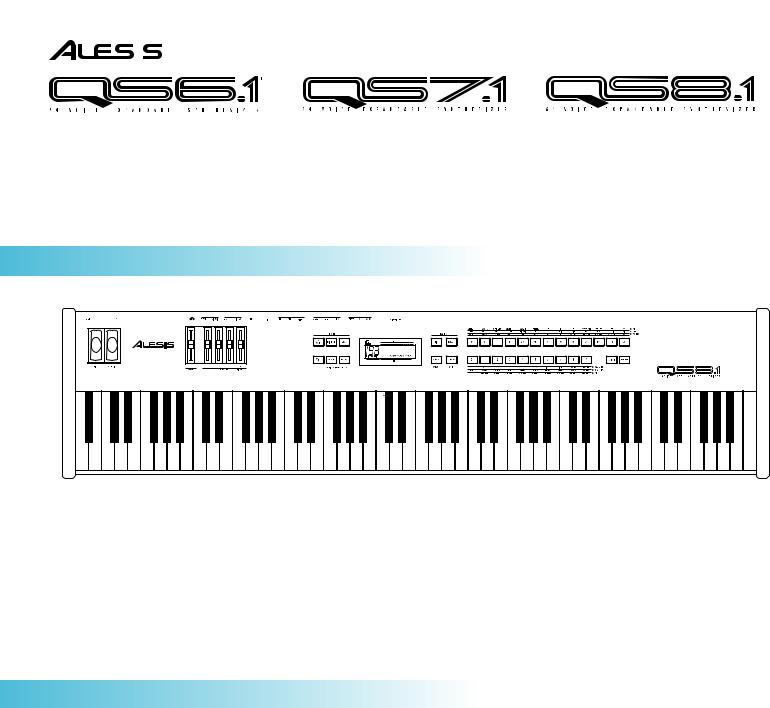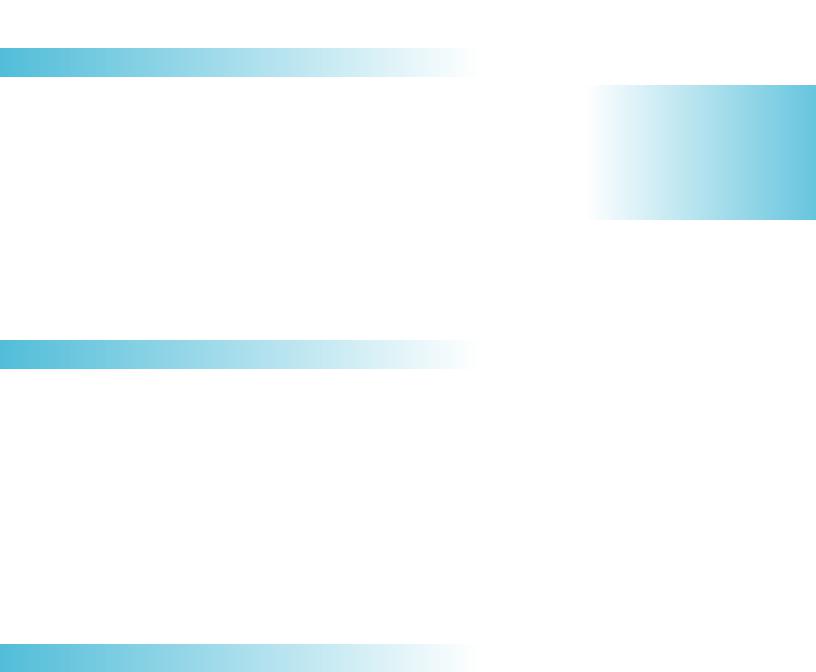Alesis QS61 User Manual

|
TM |
TM |
TM |
|
Quick Reference Guide
Front Panel Controls
Pitch Bend Wheel - temporarily changes the instrument’s tuning
Modulation Wheel - adds effects like vibrato and tremolo; its effect can be different from one Program to the next
Master Volume - determines the output level of the analog outputs Controller A-C Sliders - modulates a sound in Program or Mix mode
Controller D / Edit Value Slider - modulates a sound in Program or Mix mode, changes the currently selected parameter in any of the Edit modes
Value buttons - increase or decrease the currently selected parameter, or let you scroll backward and forward through Mixes or Programs
Edit Select button - determines which Edit Mode is selected (Mix Edit, Program Edit, Effects Edit or Global Edit)
Store button - lets you store an edited Program or Mix into internal memory, or a sound card, or to external MIDI devices
Page buttons - move the display between the various pages of a selected Function Mix button - selects Mix Mode
Program button - selects Program Mode
Bank buttons - let you switch between banks in Mix/Program Play Mode Compare button - compares an edited Mix or Program to its original version Global button - gives you access to parameters that control the entire instrument including master tuning/transposition and keyboard sensitivity
00-120 Buttons - in Program and Mix modes these select the sound group (Pianos, Brass, etc.), in Edit modes these select parameters to be edited
0-9 Buttons - in Mix or Program modes these select individual Programs/Mixes, in Edit modes these select parameters to be edited
QS Quick Facts
Welcome to the QS-Series Synthesizer Quick Reference Guide. This is a supplement to the manual designed to quickly get you up and running with these keyboards. Some of the key features of the QS include:
•16 MB of Sound ROM standard
•Expandable to 32 MB via our 8 MB PCMCIA format QCards
•Up to 16 MB of user sample storage available through Flash RAM PCMCIA cards
•True 64 Note Polyphony
•4 High Quality Multieffects Busses
•ADAT Optical Digital Outputs
•4 Independant Analog Outputs
•4 Realtime Controller Sliders
•Built-In Serial port for direct Mac™ or PC connection
•Extensive Tracking Generator and Matrix Modulation sections
•88 Note Weighted (QS8.1), 76 Note Semi-Weighted (QS7.1), or 61 Note Semi-Weighted (QS6.1) Keyboard with Aftertouch and Release Velocity
•Included CD-ROM with Sequencing and Sound Editing Applications and Files
For more information please refer to the QS Reference Manual that comes with your keyboard.

How To Play The Demos
The QS is equipped with five demo sequences to show a few of its Programs and Effects in various musical styles. To listen to the demo sequences:
1.Press and hold the MIX button.
2.Press the 0,1,2,3 or 4 button.
3.You can adjust the volume in the headphones or speakers with the VOLUME knob, and you can press the MIX button to stop the demo at any time.
Some QCards are also equipped with demo sequences. To play a card sequence (if available):
Demo Credits:
0.“Jinx” by James Reynolds
1.“Bang!” by Taiho Yamada
2.“Dreamcurrents” by Erik Norlander
3.“Iron Man” by Keith Emerson
4.“Camera Obscura” by David Bryce
1.Press and hold the SEQ START button.
2.Press the 00, 10, 20, 30 or 40 button to access Card A sequences, or 50, 60, 70, 80 or 90 to access Card B sequences
3.Press any of the 0-9 buttons on the keypad. A card can be programmed to hold up to 50 Standard MIDI File sequences with Sound Bridge software. See the instructions for Sound Bridge for more information.
How To Recall Programs
The QS-Series synths have 640 Programs and 500 Mixes available internally, and adding PCMCIA RAM cards give you access to up to 2,048 Programs and 1,600 Mixes. With this many sounds available, we have given users several ways to recall specific Programs. To recall a Program on the QS:
1.Press the PROGRAM button.
2.Press the <BANK> buttons to choose a Program bank. Available choices are User, Preset1, Preset2, Preset3, GenMIDI, and up to 11 Card banks if a sound card is inserted into each slot.
3.To call up an individual Program:
a.Press the number of the Program you want to recall on the keypad, or
b.Press the VALUE up/down buttons to scroll through the Programs.
So, if you want to hear a Grand Piano Program, press the BANK> button until you have selected Bank “Pre1”, and then press 00 and 0 on the number pad. This will select Program 00, “TrueStereo”.
Program Organization
Programs are arranged into eleven catagories:
00-09: |
Pianos |
10-19: |
Chromatic |
20-29: |
Organ |
30-39: |
Guitar |
40-49: |
Bass |
50-59: |
Strings |
60-69: |
Brass |
70-79: |
Winds |
80-109: |
Synth |
110-119: |
Rhythm/FX |
120-127: |
Drums/Percussion |
So, following this layout, you can find a bass sound in any number starting with 40, such as 40, 42, 45, etc. (Exception: The Preset 4 {Pre4} bank is arranged in the General MIDI standard.)
